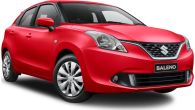The city-sized light car segment is becoming increasingly tightly contested in Australia – with fewer options and the pressure on to provide high spec levels and safety at a reasonable price.
Once strong nameplates simply haven’t been able to keep up, with popular contenders in the form of the Hyundai Accent and Honda Jazz having been axed earlier this year thanks to our unfavourable market conditions.
We’ve selected three of the most recently updated and closely specified rivals left on the scene – the facelifted Suzuki Swift GLX Turbo, nipped-and-tucked Kia Rio GT-Line, and all-new from the ground up Toyota Yaris SX - to see which makes the most sense for your dollar in 2021.
Which is the best of these light vehicles? Read on to find out.
Value
These lightweight car options are all up the price scale in this segment, with each having seen price hikes this year.
The Swift is an upper mid-grade GLX Turbo which sports a healthy safety complement and turbocharged engine, wearing an MSRP of $25,290 (that's the price before on-road costs - not a driveaway price).
Next up we have the Kia Rio GT-Line. Unlike the other cars on this test, the GT-Line is the top of the Rio range, with a sporty focus and great equipment in most areas. It also gets a turbo engine and complex dual-clutch auto. The list price for this model is $23,990, making it the value option of this mix.
Finally, there’s the new-generation Toyota Yaris SX. At $27,020 (MSRP) it’s by far the most expensive car in this test, and despite packing a good amount of standard equipment it’s only a mid-spec SX, and not the fuel-sipping signature hybrid one either.
All cars here have multimedia touchscreens with Apple CarPlay and Android Auto connectivity, although the Rio is the winner in this category with a larger 8.0-inch screen which also features wireless phone connectivity. The Rio does miss out on built-in navigation which the other two cars get, and its wireless phone connectivity can be glitchy at times.
The Yaris has the smallest and most plain-looking 15-inch alloys, while the Swift gets 16-inch wheels, both cars wear eco-focused tyres as standard. The Rio again appears to take the cake for wheel looks with its relatively huge 17-inch alloys wrapped in expensive Continental performance rubber.
However, the Rio is the only car here which doesn’t get keyless entry or push-start ignition, nor LED headlights, making do with a turn-key and halogen projectors respectively. The Yaris ups the headlight ante to include adaptive/auto on-off high beams.
All cars also score colour multifunction displays in the driver’s instrument binnacle, but none have holographic head-up displays. All cars on this test also make do with cloth seat trim, although the Swift gets semi-bucket seats and the Rio gets partial leatherette trim.
More on the interior over in the practicality section of this review, but for now check out our table below for a full breakdown of the key items available on each car. The winner for value? It has to be the Swift which offers the best bang for buck no matter which way you slice it, though the Rio is the cheapest based on list prices.
| Yaris | Rio | Swift |
Price and features | 6 | 8 | 8 |
Design | 8 | 8 | 7 |
Practicality | 7 | 8 | 6 |
Engine and transmission | 7 | 8 | 8 |
Fuel consumption | 7 | 6 | 7 |
Safety | 9 | 7 | 8 |
Ownership | 8 | 8 | 7 |
Driving | 8 | 8 | 7 |
| 60 (7.5/10) | 61 (7.6/10) | 58 (7.3/10) |
| Yaris | Rio | Swift |
Multimedia screen | 7.0-inch | 8.0-inch | 7.0-inch |
Apple CarPlay/Android Auto | Yes | Yes, wireless | Yes |
Built-in sat-nav | Yes | No | Yes |
Keyless entry & push-start | Yes | No | Yes |
Headlights | LED | Halogen | LED |
Wheel size | 15-inch | 17-inch | 16-inch |
Cruise control | Adaptive | Standard | Adaptive |
Climate control | Yes | Yes | Yes |
Kia Rio GT Line - 8
Suzuki Swift GLX Turbo - 8
Toyota Yaris SX petrol - 6
Design
These cars exude their personalities in their exterior differences. Each recently-refreshed car has a new look for the 2021 model year, and it’s pretty clear the target audience each car is aiming for.
The Swift has had a mild update, but maintains mostly the same curvy look as before. The LED light clusters on our GLX turbo really lift its exterior presence, and its signature window line and convex windscreen are enduring signatures of its youthful appeal.
The Kia is easily the most aggressively styled car here, with its wide set bumpers, large wheels, and black contrast highlights all giving off the suggestion of a hot hatch. Its boxy angular frame is a bit more macho than the curves of either the Swift or the Yaris, and its mini dual exhaust pipes ram home that theme. Many will prefer its low-set ride, too, but when looked at alongside the others its hard not to see how the halogen headlamps detract from its otherwise contemporary look.
Finally there’s the Yaris. Following in the footsteps of most other recent Toyotas there are a lot of neat details to take in on its bodywork. I like its wide bumpers and curvy motifs running down its profile, especially the way these themes are brought together with a single-piece contrast spoiler across the middle of the boot lid.
The contoured detailing on the roof panel is a nice touch which neither of the other cars here bothered with, and the Yaris has by far the most modern-looking LED light clusters, both front and rear.
Which is the best from the outside? It’s really down to taste. I liked the maturity and detail of the Yaris but everyone else I talked to about it seemed to prefer the Rio.
On the inside is where these cars really differ. The Swift has changed the least for this update, with the same cheap-looking plastic finishes a clear give-away as to how Suzuki has managed to make it the best value car here.
The screen quality is pretty ordinary, too, and the seating position is very upright, making you feel almost like you’re at the helm of a small SUV. Suzuki has had at least the thought to put a small padded cloth panel for your elbow in the doors.
The Rio GT-Line continues its aggressive flair to a lesser extent inside with a conservative dash layout, brilliant 8.0-inch multimedia screen, and (actually pretty cool-looking) faux-carbon contrast dash materials.

The flat-bottomed wheel feels good under hand, although the hard plastics which comprise the dash-topper and door cards are hard to look past. The Rio has the lowest seating position of the three living up to its sporty nature, and while I really liked the look of its front seats, they proved to be the least comfortable and supportive on this test.
Finally, it’s hard not to be left wanting in the Yaris, given its tall pricing. There are some very cool elements and a lot of thought put into the cascading styling of the dash, but again, most of the materials just don’t cut it.

That having been said, the Yaris has very cool digital dash elements, and the most premium looking and feeling steering wheel of these three. Still, the door cards are made of a strange almost furry plastic material with no padding, and the choice to use a soft plastic for the dash topper when it could have been placed literally anywhere you might actually touch is a perplexing one.
A winner here? Again, this will be down to taste. You might pick the Yaris for its more modern design or the Rio for its aggressiveness and sensible dash. The Swift is the most dated looking of the three but isn’t without its charm either.
| Yaris | Rio | Swift |
Length | 3940mm | 4070mm | 3840mm |
Width | 1695mm | 1725mm | 1735mm |
Height | 1505mm | 1450mm | 1495mm |
Weight (tare) | 1055kg | 1197kg | 925kg |
Turning circle | 10.2m | 10.2m | 9.6m |
Kia Rio GT Line - 8
Suzuki Swift GLX Turbo - 7
Toyota Yaris SX petrol - 8
Practicality
You’re probably not looking for a car in this segment if you intend on frequently carrying lots of people or things, but is there a winner amongst the choices here?
Let’s start with the Swift. Definitely known in the past as a city-slicker, not much has changed in recent years. The Swift has tight dimensions width-wise, but offers great headroom thanks to its bulbous roof. As already mentioned, the seating position feels high for front passengers, not helped along by how the interior design has you peering downward on the instruments. While the synthetic seat trim looks cheap, the foam material underneath is soft and comfortable, and the side-bolstering front passengers get is excellent in the corners.
The Swift scores dual cupholders in front of the transmission which fit large coffee cups but are a bit height-limited so didn’t fit our 500mL test bottle. There are small binnacles in the doors and a small binnacle under the climate controls to suit wallets or phones. A third smallish cupholder is available for either front or rear passengers.
Rear passengers are near forgotten in the Swift, with tight dimensions thanks to a descending window line and a seat which isn’t really much more than a foam bench. Legroom was surprisingly more than adequate, but the seats here really miss out on the support and comfort available to front passengers. There are no adjustable air vents or power outlets either, and the bottle-holders available in the doors are small.
The Swift also has the smallest boot on this test, weighing in at 242 litres (VDA). The space is tight enough that our largest 124L CarsGuide travel case could only just fit.
Moving on to the Rio and things are immediately much better, even space-wise for front passengers. The low seating makes the most of this car’s height, and its glasshouse means the cabin feels much less restricted than the other two cars here. The Rio is the only car on this test with a centre console storage box with armrest, and offers large cupholders placed alongside the handbrake, large bottle holders integrated into binnacles in the doors, and a two-tiered shelf in front of the transmission for an excellent cabin storage complement.
As we mentioned, while the Rio GT-Line scores some cool stitched seat trim with a contrasting cloth and leather design, the front seats are the least supportive on this test. Back seat occupants have not been forgotten though, as the Rio offers leagues of legroom for a car in this class, and the excellent trim continues for rear passengers, too.
Rear passengers also benefit from a healthy amount of headroom, as well as a single USB port – making the Rio the only car on this test with a rear power outlet. There are still no adjustable air vents, however.
The Rio’s boot is also by far the largest of these three, coming it at 325L (VDA), easily consuming our largest 124L travel case with space to spare.
Finally, we have the Yaris. Its interesting dash design looks more practical than it is mainly because none of the storage cutaways are rubberised, leaving objects vulnerable to an express exit when cornering. It still gets its fair share of storage in the cabin though, with three small but useful cupholders running down the centre, a large storage area under the climate controls, but small bottle holders in the doors which struggled to fit our large test bottle.
The seats land about the middle of the three cars on test in terms of comfort, with decent padding and support on offer. The seats are clad in a typically Toyota rugged synthetic cloth. Head room is excellent for the driver, but not so much for the passenger, with that seat lacking height adjust and taller occupants needing to duck down so as not to hit the headlining.
The rear seat is claustrophobic, with a door which doesn’t open particularly wide in the first place. Once you’re inside the black headliner and small rear windows conspire for a claustrophobic space, although the rear seat design is more contoured and comfortable than it is in the Swift. The door cladding takes a turn for the worse, trading the odd furry plastic for a single-piece hard plastic insert no good for elbows. Legroom and headroom is noticeably tight behind my own driving position.
Rear passengers in the Yaris also miss out on any kind of connectivity and there are no adjustable air vents either. The boot of the Yaris is middle of the pack, at 270L (VDA) - enough for the big case to fit.
All cars on this test have space-saver spare wheels under the boot floor (although the Rio could fit an alloy) and dual ISOFIX plus three top-tether child seat mounting points across the rear seats.
The clear winner here is the Rio with its ample cabin storage and huge boot which could be in the class above.
| Yaris | Rio | Swift |
Boot space (seats up) | 270 litres | 325 litres | 242 litres |
Boot space (seats down) | No official figure | 980 litres | 918 litres |
Spare | Space saver | Space saver | Space saver |
Kia Rio GT Line - 8
Suzuki Swift GLX Turbo - 6
Toyota Yaris SX petrol - 7
Engine and transmission
All cars here are powered by three-cylinder petrol engines which drive the front wheels, and all three are closely matched on power outputs.
The Swift GLX Turbo and Rio GT-Line both have 1.0-litre three-cylinder turbocharged engines, with the Swift producing 82kW/160Nm and the Rio GT-Line producing 74kW/172Nm.
Meanwhile the Yaris SX ups the engine size to 1.5-litres but lacks a turbo, still putting out a healthy 88kW/145Nm.
Where these cars are quite different is in their transmissions. The Yaris has a continuously variable transmission (with a launch gear - like a conventional first gear for take-offs, before it switches to that familiar elasticity of CVT auto gearboxes we know well by now), while the Swift has a six-speed torque converter automatic, and the Rio has a seven-speed dual-clutch automatic.
Only the Swift has paddle-shifters to control its transmission, and only the Rio has a stop/start function. The Swift is the only car without alternate drive modes with the Rio and Yaris each featuring three modes. All three cars have manual handbrakes.
| Yaris | Rio | Swift |
Layout | 3-cylinder 1.5-litre | 3-cylinder 1.0 litre turbo | 3-cylinder 1.0 litre turbo |
Power | 88kW | 74kW | 82kW |
Torque | 145Nm | 172Nm | 160Nm |
Transmission | CVT auto | 7-speed dual-clutch | 6-speed torque converter |
Kia Rio GT Line - 8
Suzuki Swift GLX Turbo - 8
Toyota Yaris SX petrol - 7
Fuel consumption
You might assume small cars like these - some of the lightest cars on the road - are fuel sippers, but with a lot of old engine tech in affordable cars this can be a bit of a myth.
Our cars here don’t have old engines but aren’t amazing on fuel despite what the sticker might say. Official figures for each of the cars here come in at 5.1L/100km for the Swift GLX Turbo, and 5.4L/100km for both the Yaris SX petrol and turbocharged Rio GT-Line.
Our real-world test measured at the pump over the same terrain and distance had the Swift and Yaris both consumed 7.4L/100km, while the Rio overshot the mark by the most, consuming 9.4L/100km.
This makes the Yaris a surprise, as it was closest to its claimed fuel use - and unlike the Swift, it can drink base-grade 91RON.
The Rio can also sip the cheap fuel, while the Swift requires mid-shelf 95RON premium unleaded. The Swift also has the smallest fuel tank, with the Rio offsetting its thirst with a larger fuel capacity. See the table below for details.
| Yaris | Rio | Swift |
Official combined | 5.4L/100km | 5.3L/100km | 5.1L/100km |
Real-world test | 7.4L/100km | 9.4L/100km | 7.4L/100km |
% difference | 37 per cent | 77 per cent | 45 per cent |
Minimum RON rating | 91 | 91 | 95 |
Fuel tank size | 40L | 45L | 37L |
Kia Rio GT Line - 6
Suzuki Swift GLX Turbo - 7
Toyota Yaris SX petrol - 7
Driving
Our test loop for these three cars included a good split of city driving, a short amount of freeway driving, and some curvy national park roads to round out the experience.
All three cars performed admirably, although each exhibited strengths and weaknesses.
Suzuki Swift GLX Turbo
The Swift surprised us with how well it kept up with the other two on this test. One might assume from its budget origins it might be lacking dynamically in the corners, but that was not the case.
Make no mistake, the Swift GLX Turbo is a fun little car to drive both in and out of the city. Its engine and transmission seemed the least stressed of these models when loaded up with three occupants and driven up a hill, and always had plenty of power in reserve. Its six-speed auto was the most dependable transmission of these cars too, with predictable and linear progression both up and down the gears.
The ride in the Swift is a mixed bag. The front suspension is soft, helping it deal with bumps in the city well, while its torsion beam rear unsettled it on harsher surfaces, where you could really feel the unevenness between this car’s axles. The taut rear-end did have a benefit of keeping the Swift truly under control in the corners, however. Overall the GLX Turbo manages to split the difference between the ride of the other two cars. It’s not as harsh as the Rio, but not as sophisticated and comfortable as the Yaris.
Kia Rio GT-Line
Next up is the Rio GT-Line. This car felt as sporty as it looks - for better or worse.
You’ll notice its harsh interior appointments are met with a sharp and noisy ride around town. The 17-inch wheels look great but allow a lot of tyre roar to penetrate the cabin at all speeds. The wheels also don’t help with the ride which can be quite rough over uneven and corrugated roads.
Also immediately annoying in the Rio is the weird steering. It’s artificially weighted in all driving modes, with it feeling far too heavy in Normal or Eco, then disarmingly light in Sport. This seems the wrong way around to us.
It has the most complicated drivetrain, with a dual-clutch automatic mated to a turbocharged engine with stop start. This can be inconvenient around town, as the Rio does have to overcome a dollop of turbo-lag from a standstill. The dual-clutch also isn’t as super slick as some VW Group units can be, and can be caught off-guard on occasion.
Where the Rio comes alive though is when you’ve got a bit of open road and a few corners. With its aggressive rubber, firm chassis and suspension, and direct (if a little light) steering in Sport mode, this car was an absolute pleasure to steer. Its gnarly little turbo three-pot had by far the best note of the three, and I was astounded by how stark the difference was between the roadholding of this car and the other two. It’s by far the driver’s choice but get ready to fork out for pricey replacement rubber.
Toyota Yaris SX petrol
Finally, there’s the Yaris. Is there any benefit behind the wheel for its hefty extra cost? Turns out, there certainly is. Toyota has gone to town with its TNGA underpinnings and made this car comfortable and confident. Its ride is so well balanced between soaking up bumps and turning into corners it easily ranks as the nicest car to be behind the wheel of, both in and out of town.
The Yaris’ steering is superbly weighted on the lighter side, and I’d say its cabin ergonomics were the best, too.
Yes, it has a CVT automatic, which I know will have some readers rolling their eyes, but it certainly doesn’t feel like it – even when pushed it jumps through its artificially stepped ratios nicely without much of the CVT signature rubbery feeling, and around town takes off from the lights smoothly too thanks to that 'launch gear'.
The Yaris’ 1.5-litre engine keeps up on the power front and progresses with some urgency when you need it but still lacks the turbocharged shove that makes the other two cars on this test so much fun.
This engine also makes an ugly sound at 3000rpm and above, and it’s loud a lot of the time. This is an avoidable shame, and really takes you out of its otherwise relatively quiet and comfortable cabin ambiance.
Another area we really noticed the Yaris couldn’t keep up was its stock tyres. On our open road section of the drive they limited the Yaris’ cornering appeal compared to the other cars on test quite notably. At least this one is an easy fix.
Really then, the Yaris has its best traits in the city where it belongs. We asked ourselves on the drive day which of the three cars here we’d rather take home if you had to drive it every day for the next six months, and two out of three agreed the Yaris was easily the go despite a handful of shortcomings.
Kia Rio GT Line - 8
Suzuki Swift GLX Turbo - 7
Toyota Yaris SX petrol - 8
Safety
A big factor in the continually increasing price of small cars is the requirement to comply with ever more stringent ANCAP safety requirements in our market.
All cars here deliver with decent active suites, with a minimum of auto emergency braking (AEB) and lane keep assist.
These systems aren't built equal though, and the Yaris scores pedestrian detection at day and night, cyclist detection during the day, and a new oncoming intersection brake feature. The Yaris' AEB system works from 10-180km/h.
Meanwhile the Swift's AEB suite works from 5-100km/h and only detects vehicles and pedestrians, but not explicitly cyclists. Suzuki does not specify whether the system is able to detect all objects at night.
Finally the Rio's AEB system will brake the vehicle between 10-75km/h for vehicles and 10-85km/h for pedestrians or cyclists. The wording around the Rio's AEB system is the most vague and suggests the system may not operate at night or bring the vehicle to a full stop in some scenarios. Worth keeping in mind.
Only the Swift scores blind spot monitoring and rear cross traffic alert in the grade seen here, while the Rio is the only car to miss out on adaptive cruise control, but gains driver attention alert.
The Yaris is the only car with traffic sign recognition and adaptive high beam headlights. Elsewhere, the Yaris scores an innovative eight-airbag complement (driver, passenger, dual centre, dual side, dual curtain) compared to the Swift and Rio’s six airbags (dual frontal, dual side, dual curtain), and has the most recently developed chassis crumple zones.
All cars here wear maximum five-star ANCAP safety ratings, but only the Yaris is rated to the strict 2020 standard. The Rio and Swift’s scores both date to 2017.
Without conducting a real-world crash test, we can deduce the Yaris is the safest car here, but the Swift is still a strong contender considering its inclusion of blind spot monitoring and rear cross traffic alert at its price-point.
See the table below for more detail.
| Yaris | Rio | Swift |
Auto emergency braking | Yes | Yes | Yes |
Lane keep assist | Yes | Yes | Yes |
Blind spot monitoring | No | No | Yes |
Adaptive cruise control | Yes | No | Yes |
Rear cross traffic alert | No | No | Yes |
Driver attention alert | No | Yes | No |
Traffic sign recognition | Yes | No | No |
Airbags | Eight | Six | Six |
ANCAP rating | Five stars (2020) | Five stars (2017) | Five stars (2017) |
Kia Rio GT Line - 7
Suzuki Swift GLX Turbo - 8
Toyota Yaris SX petrol - 9
Ownership
Despite one car here having a clear 'at a glance' advantage, the playing field is more even than you think.
Kia’s Rio seems to be the winner with its seven-year/unlimited kilometre warranty. The other two cars here have industry-standard five-year/unlimited kilometre coverage, although the Swift’s is dependent on you continually servicing on time with Suzuki. The Yaris’ powertrain warranty can run up to seven years if you maintain logbook service history (either with Toyota or not), which is worth keeping in mind.

When it comes to service pricing the Toyota is by far being the cheapest here to maintain. Its capped price services are locked at $195 for the first five visits. Excellent.
Next up, the Suzuki sits in the middle with its services over the fist five years coming in at an average of $295 per year.
Finally, the Rio is by far the most expensive of the three with its average yearly service cost coming in at a whopping $457 for the life of the warranty.
Service intervals are 12 months or 10,000km for both the Swift and the Rio and their turbocharged engines, while the Yaris is slightly less frequent and can visit the shop at 12 monthly or 15,000km intervals.
The Suzuki offers five years' roadside assist free, and the Kia bags an impressive seven years of complimentary roadside assist. Toyota doesn't offer any free roadside cover - you have to pay an annual fee.
| Yaris | Rio | Swift |
Warranty length | Five years/unlimited km | Seven years/unlimited km | Five years/unlimited km |
Conditions | Extendable to seven if serviced with Toyota | None | Must service with Suzuki |
Yearly average service price | $195 | $457 | $295 |
Service interval | 12 month/15,000km | 12 month/10,000km | 12 month/10,000km |
Roadside assist | Annual fee | Seven years included | Five years included |
Kia Rio GT Line - 8
Suzuki Swift GLX Turbo - 7
Toyota Yaris SX petrol - 8
Verdict
When we ran all the numbers for each of our CarsGuide scoring criteria, I was genuinely surprised to see how close this race was. Each of these hatchbacks is an excellent choice in the segment, and each have their own clear pros and cons in the specs tested here.
Ultimately then it will come down to taste. The Kia Rio GT-Line offers a healthy dose of sportiness and aggression with by far the most room, but it’s also the least comfortable of these three around town and packs the lightest list of active safety items.
The Suzuki Swift GLX Turbo is the value buyer’s choice. It packs in the most gear for the least coin as well as being a fun and comfortable little car to steer. It’s also the least friendly to rear occupants and has a tiny boot, so it won’t be for absolutely everyone.
Finally, there’s the Toyota Yaris SX petrol. There’s no getting around its high price, especially since it isn’t a fuel sipping hybrid. It’s super well equipped though, with the most advanced safety complement of this group and it also has by far the most comfortable ride around town. We think it will suit a buyer less concerned about upfront cost and more conscious of having a high-tech and smooth car with a small footprint.
Overall scores:
| Score | |
| Kia Rio GT Line | 7.6/10 |
| Suzuki Swift GLX Turbo | 7.3/10 |
| Toyota Yaris SX petrol | 7.5/10 |
























































































































































.jpg)
 (1).jpg)
.jpg)




































.jpg)
.jpg)
.jpg)

.jpg)
.jpg)
